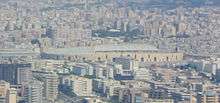Camille Chamoun Sports City Stadium
 | |
| Location |
|
|---|---|
| Coordinates | 33°52′1.55″N 35°29′46.09″E / 33.8670972°N 35.4961361°E |
| Owner | Lebanese Government |
| Operator | Lebanese Government |
| Capacity | 48,837 |
| Field size | 102 x 70 meters |
| Surface | Grass, Concrete |
| Construction | |
| Broke ground | 1955 |
| Opened | 1957 (destroyed 1982) |
| Rebuilt | 1997 |
| Construction cost | US$ 100 million (150 billion Lebanese Pounds) |
| Architect | Laceco Architects & Engineers |
| Tenants | |
| Lebanon national football team | |
Camille Chamoun Sports City Stadium (Arabic: ملعب مدينة كميل شمعون الرياضية) is a multi-purpose stadium with a capacity of 48,837 seats, located in the Bir Hassan area of Beirut, Lebanon. It is the largest stadium in Lebanon. The stadium is currently used mostly for football matches and it also has athletics facilities.
History
It was built in 1957 by the Lebanese Ministry of Youth & Fine Arts in the presidency of Camille Chamoun. The opening game was a friendly played against FC Petrolul Ploieşti, where Lebanon won 1-0 through a goal scored by Joseph Abou Murad.[1] The stadium was completely demolished in the Israeli Invasion of 1982. Consequently, former Lebanese PM Rafic Hariri initiated a project to rebuild the stadium in preparation for the 2000 AFC Asian Cup. The reconstruction received funding from the Kingdom of Saudi Arabia and Kuwait, with respective contributions of 20 million and 5 million U.S. dollars. The other 75 million U.S. dollars were provided by the Lebanese government. The renovation process of the bordering "Pierre Gemayel Hall" was also included in the overall project.
Designed by Laceco Architects & Engineers, the stadium spans 50,000 square meters of space with 77,000 square meters of covering roofs and seven kilometers of fences. A presidential gallery of 37 seats towers over the pitch, fenced off by bullet-proof glass. In addition to a 600 square meter parking lot was built underneath the stadium and another 20,000 square meter lot outside. The structure is capable of absorbing earthquakes up to 8.6 degree on the Richter scale. Moreover, administration offices, a complex for Lebanon’s Olympic committee and various other sports federations, ultra-modern press centers, clinics to handle emergencies among players and spectators with a parking lot for ambulances and fire engines, have been built beneath the stands.[2] An indoors sports complex north to the stadium was built with a 3,300 strong spectator capacity for basketball, volleyball and gymnastics. This part was scheduled to be completed by 1998.
Kvarner, the contracting company, said that 25 British and 115 Lebanese engineers toiled along with 850 Lebanese and Arab workers to rebuild the sports city that was originally inaugurated by the late president Camille Chamoun in 1957.
After the reconstruction, the stadium hosted the 1997 pan Arab games where the Lebanese president Elias El Hrawi delivered an opening speech saying: "From Lebanon we say to the world; the Lebanese have returned to their heritage and unity, they have returned to build a Lebanon for heroes, youth and peace". The Lebanese PM also delivered a speech saying:"Construction won over destruction, and peace over war". Finally, the president of the Pan Arab Committee said: "This is a tournament of solidarity between the Lebanese people who have established credibility in their country and given rise to this great sporting event". "Bombs can destroy a city but can never shake the faith of believers".[3] Additionally, the stadium was the main venue for the 1999 Arab Championship, the 2000 Asian Cup, and recently the sixth Jeux de la Francophonie held from September 27 to October 3 of 2009.
In 2015, many improvements were made to the stadium to serve the Lebanese football team during the 2018 FIFA World Cup qualifiers.
The stadium is ranked 168th in the list of association football stadiums by capacity, tied with Nagai Stadium located in Osaka, Japan.
Structure
- Overall capacity: 48,837 spectators
- Covered stands: 12,799
- Uncovered stands: 35,000
- Presidential stand: 37
- VIP stand: 1252
- First class stand: 3450
- Press stand: available
- Press reception hall: available
- Conference room: available (350 m²)
- Interview room: available
- Audio-visual press room: available
- Telecommunication room: available
- Commentary positions: available
- Players changing rooms: 4
- Referee changing room: 2
- Health club & drug detection: available
- Warming-up indoors: available
- Electronic display facilities: available
- Field specifications: same as Stade de France
- Number of gates: 18 external entrance gates, 56 internal entrance gates.
- Parking capacity: 2500 cars
References
- ↑ "History of Camille Chamoun Sports City Stadium". Camille Chamoun Sports City. 29 September 2009. Retrieved 18 October 2017.
- ↑ "Sports City risen". Camille Chamoun Sports City. 20 September 1997. Retrieved 18 October 2017.
- ↑ "The Eighth Pan Arab Games, An Outlook". Camille Chamoun Sports City. 12 July 1997. Retrieved 18 October 2017.
- Inglis, Simon (2000). Sightlines: A Stadium Odyssey. Yellow Jersey. ISBN 0-224-05968-8.
External links
| Preceded by Jeque Zayed Stadium |
AFC Asian Cup Final Venue 2000 |
Succeeded by Workers Stadium |